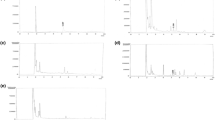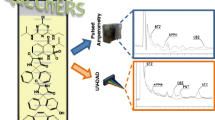Abstract
The extraction of non-volatile (NVOC), semi-volatile (SVOC), and volatile (VOC) organic compounds in water and soil samples follows well-defined protocols, already described in the specialized literature. However, for environmental matrices that are either new, complex, or difficult to define, an adaptation of the extraction procedures needs to be made. Thus, the main purpose of this paper was to find the best conditions for the extraction of NVOC, SVOC, and VOC in complex matrix samples (hydrochar-HC and process water-PW) resulting from the hydrothermal carbonization of sugar cane bagasse and vinasse. For this, a factorial design (FD) was carried out for each type of extraction and sample. Solvent and temperature were the most determining parameters for the extraction processes. The best extraction conditions for NVOC from HC were obtained using acetone, during 8 h of reflux at Soxhlet and 1.00 g of HC (50 NVOCs), while for SVOC the best conditions were those using acetone, 40 min of ultrasound, and 1.00 g of HC (50 SVOCs). For NVOC from PW, the derivatization conditions that allowed the best extraction were found at 80 °C, 30 min, and 150 μL of PW (36 NVOCs), while for SVOC, the best conditions of extraction were those using dichloromethane and 20 min in single extraction (34 SVOCs). For VOC from HC, the best conditions were 80 °C and 30 min (39 VOCs), while, from PW, these were 40 °C and 30 min (48 VOCs) of headspace equilibrium. In this way, FD enabled the adaptation of the extraction procedures for hydrochar and process water, making screening by gas chromatography-mass spectrometry (GC-MS) analysis possible.






Similar content being viewed by others
References
Cai J, Li B, Chen C, Wang J, Zhao M, Zhang K (2016) Hydrothermal carbonization of tobacco stalk for fuel application. Bioresour Technol 220:305–311. https://doi.org/10.1016/j.biortech.2016.08.098
Funke A, Ziegler F (2010) Hydrothermal carbonization of biomass: a summary and discussion of chemical mechanisms for process engineering. Biofuels Bioprod Biorefin 4:160–177. https://doi.org/10.1002/bbb.198
Mumme J, Eckervogt L, Pielert J, Diakité M, Rupp F, Kern J (2011) Hydrothermal carbonization of anaerobically digested maize silage. Bioresour Technol 102:9255–9260. https://doi.org/10.1016/j.biortech.2011.06.099
Hoekman SK, Broch A, Robbins C (2010) Hydrothermal carbonization (HTC) of lignocellulosic biomass. Energy Fuel 25:1802–1810
Xiao L-P, Shi Z-J, Xu F, Sun R-C (2012) Hydrothermal carbonization of lignocellulosic biomass. Bioresour Technol 118:619–623. https://doi.org/10.1016/j.biortech.2012.05.060
Sevilla M, Fuertes AB (2009) The production of carbon materials by hydrothermal carbonization of cellulose. Carbon N Y 47:2281–2289. https://doi.org/10.1016/j.carbon.2009.04.026
Falco C, Baccile N, Titirici M (2011) Morphological and structural differences between glucose, cellulose and lignocellulosic biomass derived hydrothermal carbons. Green Chem 13:3273–3281
Silva CC, Melo CA, Soares Junior FH, Moreira AB, Ferreira OP, Bisinoti MC (2017) Effect of the reaction medium on the immobilization of nutrients in hydrochars obtained using sugarcane industry residues. Bioresour Technol 237:213–221. https://doi.org/10.1016/j.biortech.2017.04.004
Melo CA, Junior FHS, Bisinoti MC, Moreira AB, Ferreira OP (2017) Transforming sugarcane bagasse and vinasse waste into hydrochar in the presence of phosphoric acid: an evaluation of nutrient contents and structural properties. Waste Biomass Valorization 8:1–13. https://doi.org/10.1007/s12649-016-9664-4
Bento LR, Castro AJR, Moreira AB, Ferreira OP, Bisinoti MC, Melo CA (2019) Release of nutrients and organic carbon in different soil types from hydrochar obtained using sugar cane bagasse and vinasse. Geoderma 334:24–32. https://doi.org/10.1016/j.geoderma.2018.07.034
Stemann J, Putschew A, Ziegler F (2013) Hydrothermal carbonization: process water characterization and effects of water recirculation. Bioresour Technol 143:139–146. https://doi.org/10.1016/j.biortech.2013.05.098
Poerschmann J, Weiner B, Koehler R, Kopinke FD (2015) Organic breakdown products resulting from hydrothermal carbonization of brewer’s spent grain. Chemosphere 131:71–77. https://doi.org/10.1016/j.chemosphere.2015.02.057
Fregolente LG, Miguel TBAR, de Castro ME et al (2019) Toxicity evaluation of process water from hydrothermal carbonization of sugar cane industry by-products. Environ Sci Pollut Res 26:27579–27589. https://doi.org/10.1007/s11356-018-1771-2
Danso-Boateng E, Shama G, Wheatley AD, Martin SJ, Holdich RG (2015) Hydrothermal carbonisation of sewage sludge: effect of process conditions on product characteristics and methane production. Bioresour Technol 177:318–327. https://doi.org/10.1016/j.biortech.2014.11.096
Spokas KA, Novak JM, Stewart CE, Cantrell KB, Uchimiya M, DuSaire MG, Ro KS (2011) Qualitative analysis of volatile organic compounds on biochar. Chemosphere 85:869–882. https://doi.org/10.1016/j.chemosphere.2011.06.108
Becker R, Dorgerloh U, Helmis M, Mumme J, Diakité M, Nehls I (2013) Hydrothermally carbonized plant materials: patterns of volatile organic compounds detected by gas chromatography. Bioresour Technol 130:621–628. https://doi.org/10.1016/j.biortech.2012.12.102
Skoog DA, West DM, Holler FJ, Crouchey SR (2013) Cromatografia Gasosa. In: Fundamentos de Química Analítica, 8th edn. CENGAGE Learning, São Paulo, pp 899–923
Becker R, Dorgerloh U, Paulke E, Mumme J, Nehls I (2014) Hydrothermal carbonization of biomass : major organic components of the aqueous phase. Chem Eng Technol 37:511–518. https://doi.org/10.1002/ceat.201300401
Uekane TM, Rocha-leão MHM, Rezende M (2013) Compostos Sulfurados no Aroma do Café : Origem e Degradação. Rev Virtual Química 5:891–911. https://doi.org/10.5935/1984-6835.20130064
Priyangini F, Walde SG, Chidambaram R (2018) Extraction optimization of pectin from cocoa pod husks (Theobroma cacao L.) with ascorbic acid using response surface methodology. Carbohydr Polym 202:497–503. https://doi.org/10.1016/j.carbpol.2018.08.103
Casagrande M, Zanela J, Wagner A et al (2018) Influence of time, temperature and solvent on the extraction of bioactive compounds of Baccharis dracunculifolia: in vitro antioxidant activity, antimicrobial potential, and phenolic compound quantification. Ind Crop Prod 125:207–219. https://doi.org/10.1016/j.indcrop.2018.08.088
Berger-Brito I, Machour N, Morin C, Portet-Koltalo F (2018) Experimental designs for optimizing multi-residual microwave-assisted extraction and chromatographic analysis of oxygenated (Hydroxylated, Quinones) metabolites of PAHs in sediments. Chromatographia 81:1401–1412. https://doi.org/10.1007/s10337-018-3584-3
Antony J (2014) Full factorial designs. In: Antony J (org) Design of experiments for engineers and scientists, 2nd. edn. Elsevier Ltd, Waltham, pp 63–85. https://doi.org/10.1016/C2012-0-03558-2
United States Environmental Protection Agency (1996) SW-846 Test Method 3540C: Soxhlet Extraction. EPA. https://www.epa.gov/hw-sw846/sw-846-test-method-3540c-soxhlet-extraction. Accessed 23 Aug 2016
United States Environmental Protection Agency (2007) SW-846 Test Method 3535A: Solid-Phase Extraction. EPA. https://www.epa.gov/hw-sw846/sw-846-test-method-3535a-solid-phase-extraction-spe. Accessed 23 Aug 2016
United States Environmental Protection Agency (2007) SW-846 Test Method 3550C: Ultrasonic Extraction. EPA. https://www.epa.gov/hw-sw846/sw-846-test-method-3550c-ultrasonic-extraction. Accessed 23 Aug 2016
United States Environmental Protection Agency (1996) SW-846 Test Method 3510C: Separatory Funnel Liquid-Liquid Extraction. EPA. https://www.epa.gov/hw-sw846/sw-846-test-method-3510c-separatory-funnel-liquid-liquid-extraction. Accessed 23 Aug 2016
Higashikawa FS, Cayuela ML, Roig A, Silva CA, Sánchez-Monedero MA (2013) Matrix effect on the performance of headspace solid phase microextraction method for the analysis of target volatile organic compounds (VOCs) in environmental samples. Chemosphere 93:2311–2318. https://doi.org/10.1016/j.chemosphere.2013.08.023
Kubwabo C, Rasmussen PE, Fan X, Kosarac I, Grenier G, Coleman K (2016) Simultaneous quantification of bisphenol A, alkylphenols and alkylphenol ethoxylates in indoor dust by gas chromatography-tandem mass spectrometry and a comparison between two sampling techniques. Anal Methods 8:4093–4100. https://doi.org/10.1039/C6AY00774K
Laborie S, Moreau-Guigon E, Alliot F, Desportes A, Oziol L, Chevreuil M (2016) A new analytical protocol for the determination of 62 endocrine-disrupting compounds in indoor air. Talanta 147:132–141. https://doi.org/10.1016/j.talanta.2015.09.028
Rossignol S, Couvidat F, Rio C, Fable S, Grignion G, Savelli, Pailly O, Leoz-Garziandia E, Doussin JF, Chiappini L (2016) Organic aerosol molecular composition and gas-particle partitioning coefficients at a Mediterranean site (Corsica). J Environ Sci (China) 40:92–104. https://doi.org/10.1016/j.jes.2015.11.017
Shahidi F, Naczk M (1995) Food phenolics: sources, chemistry, effects and applications. Technomic Publishing Co., Lancaster, p 331
Genuino DAD, Bataller BG, Capareda SC, De Luna MDG (2017) Application of artificial neural network in the modelling and optimization of humic acid extraction from municipal solid waste biochar. J Environ Chem Eng 5:4101–4107. https://doi.org/10.1016/j.jece.2017.07.071
Funding
The authors received financial support and scholarship from the São Paulo Research Foundation—FAPESP (Grants 2005/51242-8, 2011/00574-1, 2012/23066-4, 2013/21776-7, 2014/22400-3, 2017/13230-5, 2015/22954-1, 2017/26718-6, and 2018/15733-7). M. C. B. acknowledged support from the National Council for Scientific and Technological Development—CNPq (grants 445487/2014-3 and 307925/2012-9). O. P. F. acknowledged the support from the Ceará State Foundation for Scientific and Technological Development—FUNCAP (PRONEX PR2-0101-00006.01.00/15), and from CAPES-PROCAD (Council for the Enhancement of Higher Level Personnel/Program in National Defence) 2013 Grant 183995. M. J. L. and R. C. J. S. thanked CAPES for the master scholarship received.
Author information
Authors and Affiliations
Corresponding authors
Ethics declarations
Conflict of interest
The authors declare that they have no conflict of interest.
Additional information
Publisher’s Note
Springer Nature remains neutral with regard to jurisdictional claims in published maps and institutional affiliations.
Electronic supplementary material
ESM 1
(DOCX 595 kb)
Rights and permissions
About this article
Cite this article
Laranja, M.J., da Silva, R.C.J., Bisinoti, M.C. et al. Factorial design of experiments for extraction and screening analysis of organic compounds in hydrochar and its process water of sugar cane bagasse and vinasse. Biomass Conv. Bioref. 12, 81–90 (2022). https://doi.org/10.1007/s13399-020-01035-y
Received:
Revised:
Accepted:
Published:
Issue Date:
DOI: https://doi.org/10.1007/s13399-020-01035-y




